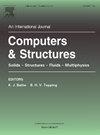Frugal wavelet transform for damage detection of laminated composite beams
IF 4.8
2区 工程技术
Q1 COMPUTER SCIENCE, INTERDISCIPLINARY APPLICATIONS
引用次数: 0
Abstract
Frugal wavelet transform (FrugWT) is a new version of discrete wavelet transform (DWT), acting as an efficient tool for detecting signal singularities. It is proven that the frugal wavelet transform usually performs better than other versions of the wavelet transforms in detecting singularities and local abrupt changes in the signals, specifically when we use wavelet functions with lower vanishing moments. FrugWT reduces the dependence of the wavelet transform on the choice of the wavelet function and thus reduces the computational time to achieve the best results from the wavelet transform for singularity detection. Therefore, this paper investigates detecting damages in laminate composite beams using a novel method called Frugal Wavelet Transform (FrugWT). Based on the first-order shear deformation theory and using the Finite Element Method (FEM), the discretized governing equations of motion are obtained. The proposed frugal wavelet transform is developed based on the one-dimensional discrete wavelet transform and multi-resolution analysis at the first level of decomposition. Three different most commonly used damage detection methods, i.e., derivative of mode shape, one-dimensional discrete wavelet transform (1D-DWT), and one-dimensional continuous wavelet transform (1C-DWT), are compared with the frugal wavelet transform. The results demonstrate that FrugWT is capable of accurately detecting damages at various locations in the laminated composite beam (LCB), even when the damage levels are below 5%. This highlights the method’s high precision and effectiveness in identifying subtle damage scenarios. Findings show that the frugal wavelet transform is robust to a given level of noise in the signal, and its performance in noisy conditions is better than the derivative of the signal, 1D-DWT, and 1D-CWT.
简小波变换在复合材料层合梁损伤检测中的应用
节俭小波变换(FrugWT)是离散小波变换(DWT)的新版本,是一种检测信号奇异性的有效工具。证明了在检测信号的奇异点和局部突变时,简型小波变换通常比其他小波变换表现得更好,特别是当我们使用小波函数的消失矩较小时。FrugWT减少了小波变换对小波函数选择的依赖,从而减少了计算时间,以达到小波变换奇异检测的最佳效果。为此,本文对层合组合梁的损伤检测方法进行了研究。基于一阶剪切变形理论,采用有限元法,得到了离散化的运动控制方程。本文提出的节约型小波变换是在一维离散小波变换和多分辨率一级分解分析的基础上提出的。将模态振型导数、一维离散小波变换(1D-DWT)和一维连续小波变换(1C-DWT)三种最常用的损伤检测方法与简约小波变换进行比较。结果表明,即使在损伤水平低于5%的情况下,FrugWT也能够准确地检测层合复合材料梁(LCB)中不同位置的损伤。这突出了该方法在识别细微损伤场景方面的高精度和有效性。研究结果表明,节俭小波变换对给定噪声水平的信号具有鲁棒性,并且在噪声条件下的性能优于信号的导数、1D-DWT和1D-CWT。
本文章由计算机程序翻译,如有差异,请以英文原文为准。
求助全文
约1分钟内获得全文
求助全文
来源期刊

Computers & Structures
工程技术-工程:土木
CiteScore
8.80
自引率
6.40%
发文量
122
审稿时长
33 days
期刊介绍:
Computers & Structures publishes advances in the development and use of computational methods for the solution of problems in engineering and the sciences. The range of appropriate contributions is wide, and includes papers on establishing appropriate mathematical models and their numerical solution in all areas of mechanics. The journal also includes articles that present a substantial review of a field in the topics of the journal.
 求助内容:
求助内容: 应助结果提醒方式:
应助结果提醒方式:


